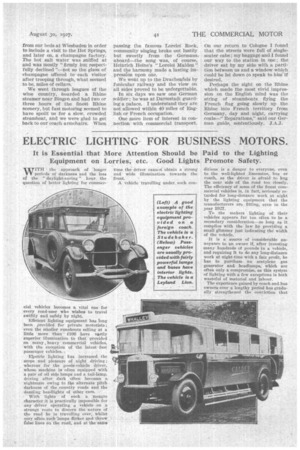ELECTRIC LIGHTING FOR BUSINESS MOTORS.
Page 45

Page 46

If you've noticed an error in this article please click here to report it so we can fix it.
It is Essential that More Attention Should be Paid to the Lighting Equipment on Lorries, etc. Good Lights Promote Safety.
WITH the approach of longer periods of darkness and the loss of the " daylight-saving" halm the question of better lighting for commer
aid vehicles becomes a vital one for every road-user who wishes to travel swiftly and safely by night.
Efficient lighting equipment has long been provided for private motorists ;
even the smaller runabouts selling at a little more than ' £100 have vastly superior illumination to that provided , on many., heavy commercial vehicles, -with the exception of the latest fast passenger vehicles.
Elpctric lighting has increased the scope and pleasure of night driving ; whereas. for the goads-vehicle driver, whose machine is often equipped with a pair of ail side lamps and a tail-lamp, driving after dark often becomes a nightmare owing to the alternate pitch darkness of the .country roads and the dazzling,headlights of other cars.
With lights of such a 'meagre character it is practically impossible for any driver operating a vehicle on 'a strange route to discern the nature of the road he is travelling over; Whilst very often Such-lamps flicker and throw false lints on the road, and at the same
time the driver cannot obtain a Strong and wide illumination towards the front.
A vehicle travelling under.. such con
clitions is a 'danger to everyone, even to the well-lighted limousine, bus or coach, as the driver is afraid to hug the near side of the road too closely. The efficiency of some of the finest coinmacial vehicles is, in fact, seriously retarded for long-distance work at night by the lighting equipment that the manufacturers are fitting, even in the year 1021.
To the makers lighting of their vehicles appears far too often to be a secondary consideration—so long as it complies with tho law by providing a small glimmer just indicating the width of the vehicle.
it is a source of considerable annoyance to. an owner if, after investing many hundreds of pounds in a vehicle, and requiring it to do any long-distance work at night-time with a fair profit, he has to purchase an acetylene gas generator and headlamps, which are often only a compromise, as this system 'of lighting with a few exceptions is bath wasteful of material and labour.
The experience gained by coach and hits owners over 'a lengthy period has gradually strengthened the conviction that electric lighting is a necessity on all vehicles, whatever argument has been used in the past against its adoption on the heavy commercial vehicle. The, coach, even when mounted on solid tyres, has demonstrated that electric lighting is almost ideal and constitutes a system which can be maintained at little cost.
The commercial success of many transport departments turns very materially upon the obviating of wasted time and labour, and both of the latter are needlessly expended upon the cleaning and attention which so often have to be given to acetylene and oil lamps.
if the special needs of any vehicle call for a system of lighting that provides a penetrating beam, whilst being reliable, simple, economical and clean, the commercial one surely has the right to Prior consideration.
When electric lighting does become a standard equipment on commercial vehicles it will also be an advance in the right direction if manufacturers will complete the outfit by fitting internal lights as well as external ones for all delivery vans.
Drivers of this type of commercial vehicle are sadly handicapped when engaged on delivery work, especially in and around country districts ; delays and mistakes are always occurring and will always do so while such inadequate facilities as oil or candle lamps have to be depended upon.
Motor vehicles have now become essential to all large departmental stores for the delivery of parcels, and the efficient handling of vast quantities bears very heavily on the shoulders of the delivery or despatch department officials, especially on certain nights of the week.
A portion of the large fleet that is
under the control of the writer is primarily engaged upon the distribution of various classes of goods : many vehicles in it are engaged on door-to-door delivery. On the latter class of work, to expedite distribution, a youth is provided to work alongside the driver ; and it is customary as the vehicle proceeds on its way for the youth to sort out the parcels for the next delivery. For those engaged on night delivery an oil or candle lamp was provided in the past for the purpose of reading lino labels and delivery sheet : the consequence was many complaints were received at various times of wrong delivery to customers ; also complaints about grease and oil being found on the parcels, due to the youth or driver tilting the lamp for the purpose of being
able to discern more easily to whom they, were addressed.
An old axiom among commercialvehicle drivers is that "an hour in the daylight is worth two at night." various tests this has been found to be literally correct in an organized delivery system. There is no doubt that after nightfall the rate of distribution of parcels falls appreciably, whilst the liability of error increases.
To correct these losses of efficiency In the particular fleets to which reference has been made electrification of the interior portion of the vans was carried out, and this has proved eminently successful, whilst being greatly appreciated by the men—their distributive capacity has increased, and at the same time they are working with greater comfort.




































































































